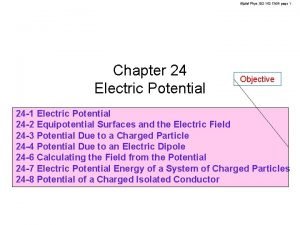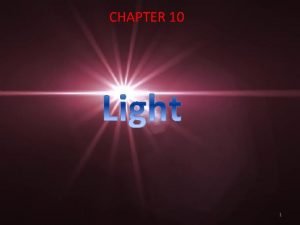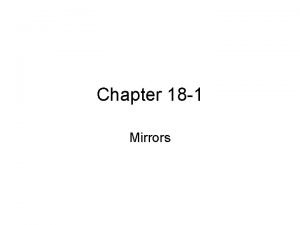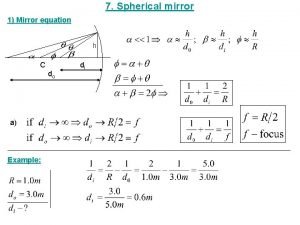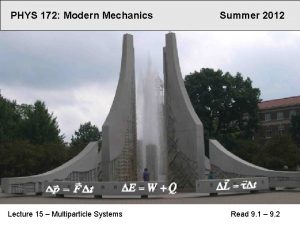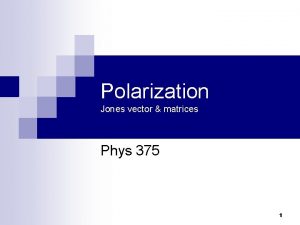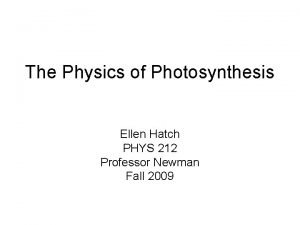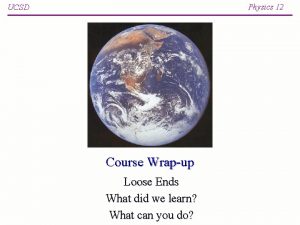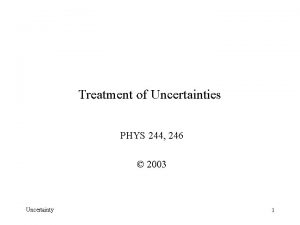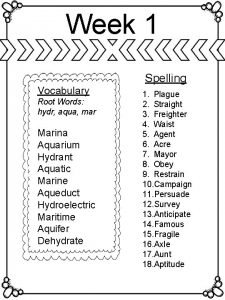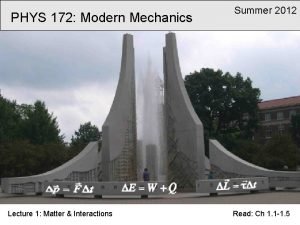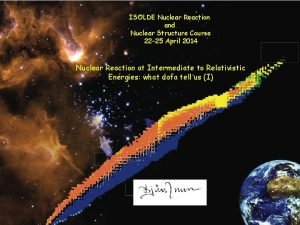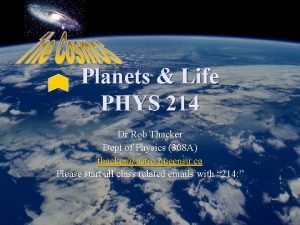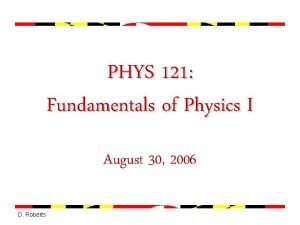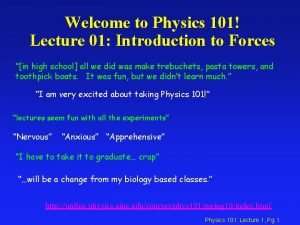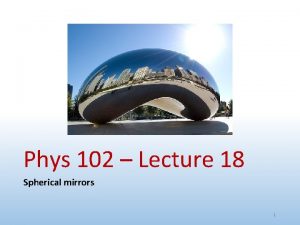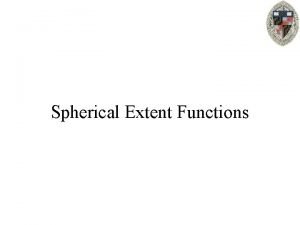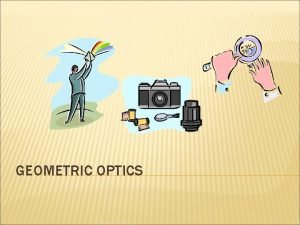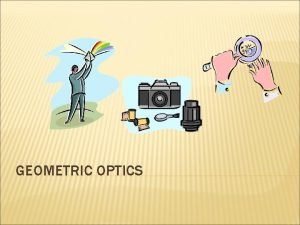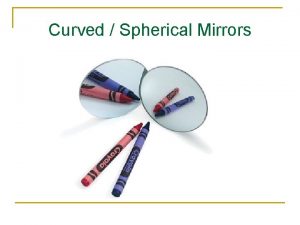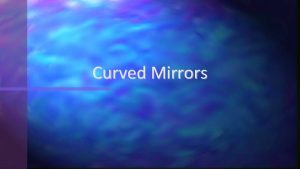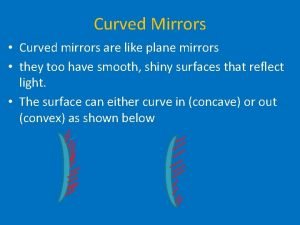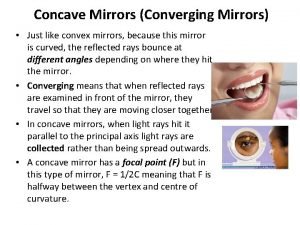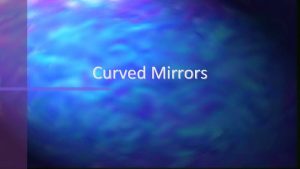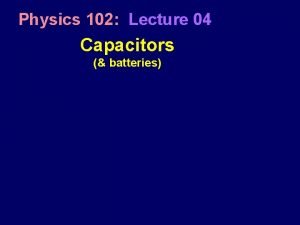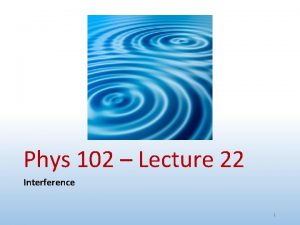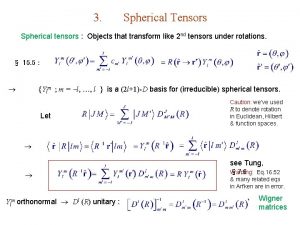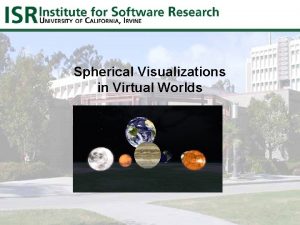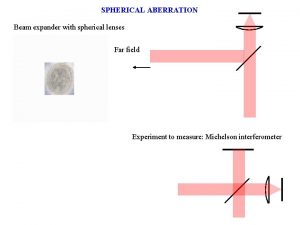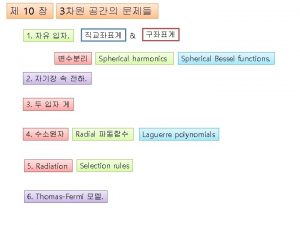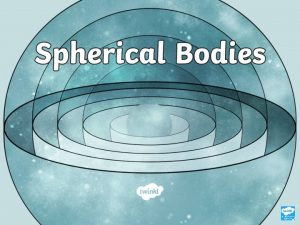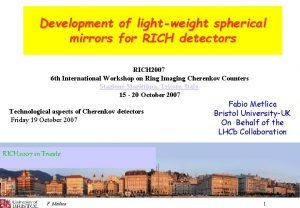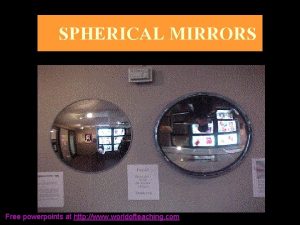Phys 102 Lecture 18 Spherical mirrors 1 Today
























- Slides: 24

Phys 102 – Lecture 18 Spherical mirrors 1

Today we will. . . • Learn about spherical mirrors Concave mirrors Convex mirrors • Learn how spherical mirrors produce images Ray diagrams – principal rays Mirror & magnification equations Phys. 102, Lecture 18, Slide 2

Curved mirrors Spherical mirror – section of a sphere “Concave” – inside surface of sphere C C R “Principal axis” R “Convex” – outside surface of sphere “Center of curvature” R C How does light reflect off spherical mirrors? Line through C and center of mirror C behind mirror “Principal axis” Phys. 102, Lecture 18, Slide 3

Concave mirror reflection Concave mirror – rays || to p. a. reflect through focal point f in front of mirror R p. a. C θ 1 θ 2 f “Focal length” DEMO Phys. 102, Lecture 18, Slide 4

Convex mirror reflection Convex mirror – rays || to p. a. reflect as if they originated from focal point f behind mirror θ 1 “Virtual rays” θ 2 R p. a. DEMO f C Since f is behind mirror, focal length < 0 Phys. 102, Lecture 18, Slide 5

ACT: Check. Point 1. 1 & 1. 2 What kind of mirror can be used to start a fire? A. Concave B. Convex C. Plane How far from the object to be ignited should the mirror be held? A. farther than the focal length B. closer than the focal length C. at the focal length Phys. 102, Lecture 18, Slide 6

Lighting a match Rays traveling through focus before hitting mirror are reflected parallel to Principal Axis. DEMO Rays traveling parallel to Principal Axis before hitting mirror are reflected through focus Phys. 102, Lecture 18, Slide 7

Images & spherical mirrors Like plane mirrors, spherical mirrors produce images of objects Key approaches: • Ray diagrams • Mirror & magnification equations Phys. 102, Lecture 18, Slide 8

Principal rays – concave mirror Ray from object traveling: 1) parallel to principal axis, reflects through f 2) through f, reflects parallel to principal axis 3) through C, reflects through C 3 Object C 2 f Image is: 1 Real (light rays cross) Inverted (opposite direction as object) Reduced (smaller than object) Phys. 102, Lecture 18, Slide 9

Principal rays – convex mirror Ray from object traveling: 1) parallel to principal axis, reflects through f 2) through f, reflects parallel to principal axis 3) through C, reflects through C 1 3 Image 2 Object f C Image is: Virtual (light rays don’t really cross) Upright (same direction as object) Reduced (smaller than object) Phys. 102, Lecture 18, Slide 10

ACT: Image formation The diagram below shows the object and image, and one ray from the object 1 2 3 Which arrow most accurately represents how the ray is reflected? A. 1 B. 2 C. 3 Phys. 102, Lecture 18, Slide 11

ACT: Check. Point 2. 1 In the ray diagram below, which ray is NOT correct? p. a. A. 1 B. 2 C. 3 1 C 2 f 3 Phys. 102, Lecture 18, Slide 12

Optical illusion Two identical concave mirrors Each mirror is positioned at the focal point of the other Image f Object DEMO Phys. 102, Lecture 18, Slide 13

Mirror & magnification equations Mirror equation Magnification Object C f Image So, Phys. 102, Lecture 18, Slide 14

Distance & magnification conventions Object Image ho do di f hi C • do = distance object is from mirror: • ho = height of object: • di = distance image is from mirror: • hi = height of image: • f = focal length mirror: • |m| = magnification: > 0: object in front of mirror < 0: object behind mirror > 0: real image (in front of mirror) < 0: virtual image (behind mirror) > 0: concave mirror +R/2 < 0: convex mirror –R/2 > 0: always > 0: image is upright < 0: image is inverted < 1: image is reduced > 1: image is enlarged Phys. 102, Lecture 18, Slide 15

Calculation: concave mirror A 6 -cm tall candle is placed 24 cm in front of a concave mirror with a focal length f = +8 cm. Determine the image location, size, and whether it is upright or inverted p. a. C f 4 cm Diagram should agree! Phys. 102, Lecture 18, Slide 16

ACT: Plane mirror Concave mirrors have f > 0 and convex mirrors have f < 0 Object What is the focal length f of a plane mirror? A. f = 0 B. f = ∞ C. f is imaginary Phys. 102, Lecture 18, Slide 17

Checkpoint 3. 1 The image produced by a concave mirror of a real object is: A. Always Real B. Always Virtual C. Sometimes Real, Sometimes Virtual Phys. 102, Lecture 18, Slide 18

ACT: Concave Mirror Where in front of a concave mirror should you place an object so that the image is virtual? A. B. C. D. Closer than the focal length Farther than the focal length Either close or far Not Possible Phys. 102, Lecture 18, Slide 19

3 cases for concave mirrors Object is: Inside f: do < f Image is: Object Upright: hi > 0 Enlarged: m > 1 C Virtual: di < 0 Between C & f: f < do < R Inverted: hi < 0 Enlarged: m > 1 f Object Image C Real: di > 0 Image f Object Past C: R < do Inverted: hi < 0 Reduced: m < 1 Real: di > 0 DEMO Image C f Phys. 102, Lecture 18, Slide 20

Calculation: convex mirror A 6 -cm tall candle is placed 12 cm in front of a convex mirror with a focal length f = – 6 cm. Determine the image location, size, and whether it is upright or inverted p. a. f C 4 cm Diagram should agree! Phys. 102, Lecture 18, Slide 21

Checkpoint 3. 2 The image produced by a convex mirror of a real object is A. always real B. always virtual C. sometimes real and sometimes virtual Phys. 102, Lecture 18, Slide 22

ACT: Convex mirror image An object placed in front of a convex mirror will ____ produce an upright image Image? Object f C A. Always B. Sometimes C. Never Phys. 102, Lecture 18, Slide 23

Summary of today’s lecture • Curved mirrors • Principal rays – method for images Parallel to p. a. –> reflects through f Through f -> reflects parallel to p. a. Through C -> reflects back through C • Mirror & magnification equations Numerical answer consistent with ray diagram Phys. 102, Lecture 18, Slide 24
 Aljalal phys 102
Aljalal phys 102 Aljalal phys 102
Aljalal phys 102 Physics 102 uiuc
Physics 102 uiuc The new cartesian sign convention for spherical mirrors
The new cartesian sign convention for spherical mirrors A flat smooth mirror
A flat smooth mirror Single concave spherical mirrors produce images that
Single concave spherical mirrors produce images that Purdue physics 241
Purdue physics 241 01:640:244 lecture notes - lecture 15: plat, idah, farad
01:640:244 lecture notes - lecture 15: plat, idah, farad For todays meeting
For todays meeting Today's lesson or today lesson
Today's lesson or today lesson Today class or today's class
Today class or today's class Today's lesson or today lesson
Today's lesson or today lesson Today meeting or today's meeting
Today meeting or today's meeting Today lesson or today's lesson
Today lesson or today's lesson Particl clicker
Particl clicker Jones matrix for half wave plate
Jones matrix for half wave plate Phys 212 equation sheet
Phys 212 equation sheet Ucsd physics courses
Ucsd physics courses Phys 244
Phys 244 Hydr root words
Hydr root words Phys 172
Phys 172 Phys. rev. c
Phys. rev. c Subtle
Subtle Phys 121 umd
Phys 121 umd Physics 101 uiuc
Physics 101 uiuc
